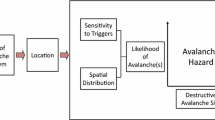Abstract
The problem of optimal forecasting of environmental changes induced by various factors is discussed. The proposed technique is based on variational principles and methods of the sensitivity theory with allowance for uncertainties in mathematical models and input data. Optimal forecasting is understood as forecasting where the estimates of cost functionals are independent of variations of the sought state functions. In addition to state functions, the forecasted characteristics include risk and vulnerability functions for receptor areas and quantification of uncertainties.
Similar content being viewed by others
References
G. I. Marchuk, Adjoint Equations and Analysis of Complex Systems [in Russian], Nauka, Moscow (1992).
R. Buizza and A. Montani, “Targeting observations using singular vectors,” J. Atmosph. Sci., 56, No. 17, 2965–2985 (1999).
D. N. Daescu and G. R. Carmichael, “An adjoint sensitivity method for the adaptive location of the observations in air quality modelling,” J. Atmosph. Sci., 60, No. 2, 434–450 (2003).
M. Ehrendorfer and J. J. Tribbia, “Optimal prediction of forecast error covariances through singular vectors,” J. Atmosph. Sci., 54, No. 2, 286–313 (1997).
R. Gelaro, R. Buizza, T. N. Palmer, and E. Klinker, “Sensitivity analysis of forecast errors and the construction of optimal perturbations using singular vectors,” J. Atmosph. Sci., 55, No. 6, 1012–1037 (1998).
H. M. Kim, M. C. Morgan, and E. Morss, “Evolution of analysis error and adjoint-based sensitivities: Implications for adaptive observations,” J. Atmosph. Sci., 61, No. 7, 795–812 (2004).
Z. Toth and E. Kalnay, “Ensemble forecasting at NMC: The generation of perturbations,” Bull. Amer. Meteor. Soc., 74, No. 12, 2317–2330 (1993).
A. Ebel and T. Davitashvily (eds.), Air, Water and Soil Quality Modelling for Risk and Impact Assessment, Springer, Dordrecht (2007).
V. V. Penenko and N. N. Obraztsov, “A variational initialization method for the correlation of fields of meteorological elements,” Meteorologiya Gidrologiya, No. 11, 1–11 (1976).
V. V. Penenko, Methods of Numerical Simulation of Atmospheric Processes [in Russian], Gidrometeoizdat, Leningrad (1981).
V. Penenko, “Some aspects of mathematical modelling using the models together with observational data,” Bull. Novosib. Comp. Center, Ser. Numer. Model in Atmosphere, Ocean Environment. Studies, 4, 31–52 (1996).
V. V. Penenko and E. A. Tsvetova, “Structure of a set of models for studying interactions in the Baikal Lake — region atmosphere system,” Atmos. Okeanic Opt., 11, No. 6, 586–593 (1998).
V. V. Penenko, “Variational data assimilation in real time,” Vychisl. Tekhnol., 10, No. 8, 9–20 (2005).
V. V. Penenko and E. A. Tsvetova, “Mathematical models for studying environmental pollution risks,” J. Appl. Mech. Tech. Phys., 45, No. 2, 260–268 (2004).
V. V. Penenko and E. A. Tsvetova, “Mathematical models of environmental forecasting,” J. Appl. Mech. Tech. Phys., 48, No. 3, 428–436 (2007).
V. Penenko and E. Tsvetova, “Orthogonal decomposition methods for inclusion of climatic data into environmental studies,” Ecol. Model., 217, 279–291 (2008).
V. Penenko and E. Tsvetova, “Discrete-analytical methods for the implementation of variational principles in environmental applications,” J. Comput. Appl. Math. (2008); http://dx.doi.org/10.1016/j.cam.2008.08.018.
L. Schwartz, Analyse Mathematique, Hermann (1967).
A. A. Samarskii and P. N. Vabishchevich, Additive Schemes for Problems of Mathematical Physics [in Russian], Nauka, Moscow (2001).
S.-J. Chen, Y.-H. Kuo, P.-Z. Zhang, and Q.-F. Bai, “Synoptic climatology of ciclogenesis over East Asia, 1958–1987,” Mon. Weather Rev., 119, No. 6, 1407–1418 (1991).
E. Kalney, M. Kanamitsu, R. Kistler, et al., “The NCEP/NCAR 40-year reanalysis project,” Bull. Amer. Meteorol. Soc., 77, 437–471 (1996).
Author information
Authors and Affiliations
Corresponding author
Additional information
__________
Translated from Prikladnaya Mekhanika i Tekhnicheskaya Fizika, Vol. 50, No. 2, pp. 156–166, March–April, 2009.
Rights and permissions
About this article
Cite this article
Penenko, V.V., Tsvetova, E.A. Optimal forecasting of natural processes with uncertainty assessment. J Appl Mech Tech Phy 50, 300–308 (2009). https://doi.org/10.1007/s10808-009-0041-y
Received:
Published:
Issue Date:
DOI: https://doi.org/10.1007/s10808-009-0041-y




